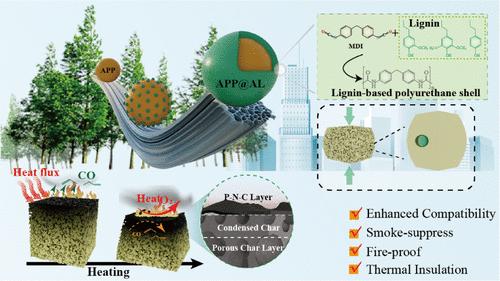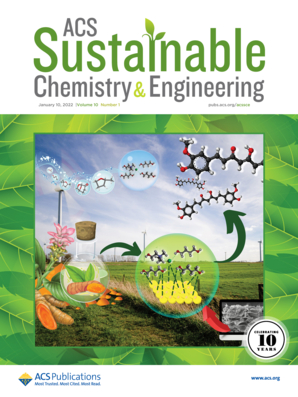Enhancing Rigid Polyurethane Foam Properties with Lignin-Based Core–Shell Intumescent Flame Retardants
IF 7.1
1区 化学
Q1 CHEMISTRY, MULTIDISCIPLINARY
引用次数: 0
Abstract
Lignin, an abundant polyphenolic biomass, has excellent carbonization potential, making it highly promising for developing ecofriendly flame retardants. This study combined ammonium polyphosphate (APP) and alkaline lignin (AL) to create a novel core–shell flame retardant, APP@AL. APP@AL was then applied to rigid polyurethane (RPU) foam to improve its flame-retardant performance and interfacial compatibility with the matrix. Results showed that the mean heat release rate and total heat release of flame-retardant RPU foam decreased by 76.8% and 65.9%, reaching 58.61 kW/m2 and 19.09 kW/m2, respectively, along with a significant improvement in smoke suppression, and TSP was decreased to 1.67 m2. The flame retardant content for each RPU was 25 wt % of the polymethylene polyphenyl isocyanate. The flame-retardant mechanism was further explained by analyzing the char layer structure and the pyrolysis gas-phase products. Moreover, APP@AL enhanced the interfacial compatibility of RPU, as verified by digital image correlation, which demonstrated an improved stress transfer efficiency during compression. Compared with unmodified RPU foam, APP@AL-modified RPU showed a 10.3% increase in compressive strength and a 6.2% reduction in thermal conductivity. This work provided a novel strategy for thermal insulation, reinforcement, and smoke suppression of rigid polyurethane foams.

木质素基核壳膨胀阻燃剂增强硬质聚氨酯泡沫性能
木质素是一种丰富的多酚类生物质,具有良好的炭化潜力,是开发环保型阻燃剂的重要材料。本研究将聚磷酸铵(APP)与碱性木质素(AL)结合制备新型核壳阻燃剂APP@AL。然后将APP@AL应用于硬质聚氨酯(RPU)泡沫中,以提高其阻燃性能和与基体的界面相容性。结果表明:阻燃RPU泡沫的平均放热率和总放热率分别下降了76.8%和65.9%,分别达到58.61 kW/m2和19.09 kW/m2,抑烟效果显著提高,TSP降至1.67 m2;每个RPU的阻燃剂含量为聚亚甲基聚苯基异氰酸酯的25%。通过对炭层结构和热解气相产物的分析,进一步解释了阻燃机理。此外,APP@AL增强了RPU的接口兼容性,数字图像相关验证了这一点,这表明压缩过程中的应力传递效率有所提高。与未改性的RPU泡沫相比,APP@AL-modified RPU的抗压强度提高了10.3%,导热系数降低了6.2%。这项工作为硬质聚氨酯泡沫的保温、增强和抑烟提供了一种新的策略。
本文章由计算机程序翻译,如有差异,请以英文原文为准。
求助全文
约1分钟内获得全文
求助全文
来源期刊

ACS Sustainable Chemistry & Engineering
CHEMISTRY, MULTIDISCIPLINARY-ENGINEERING, CHEMICAL
CiteScore
13.80
自引率
4.80%
发文量
1470
审稿时长
1.7 months
期刊介绍:
ACS Sustainable Chemistry & Engineering is a prestigious weekly peer-reviewed scientific journal published by the American Chemical Society. Dedicated to advancing the principles of green chemistry and green engineering, it covers a wide array of research topics including green chemistry, green engineering, biomass, alternative energy, and life cycle assessment.
The journal welcomes submissions in various formats, including Letters, Articles, Features, and Perspectives (Reviews), that address the challenges of sustainability in the chemical enterprise and contribute to the advancement of sustainable practices. Join us in shaping the future of sustainable chemistry and engineering.
 求助内容:
求助内容: 应助结果提醒方式:
应助结果提醒方式:


